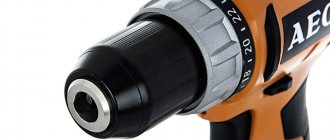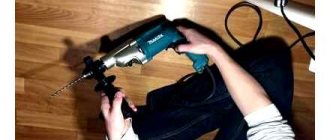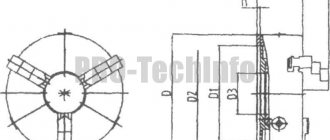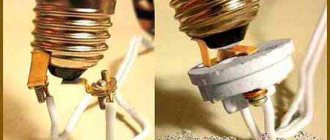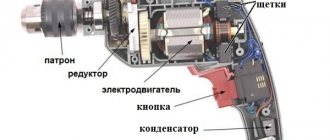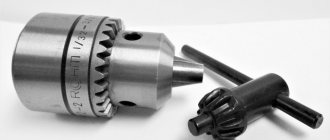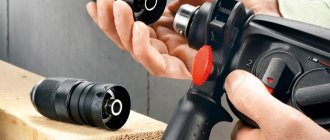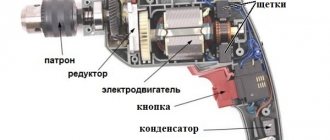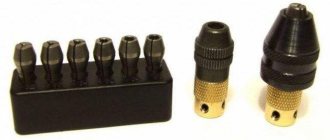Classification of cartridges
The following types of cartridges exist:
- quick-release or self-clamping device;
- collet-type sds devices;
- cam
On a drill with a quick-release chuck, you can change a drill or other attachment quite quickly, without the need to use any additional devices. The cartridges of the first option are divided into single- and double-coupling devices.
Single-coupling devices have a shaft locking system that is activated during tool replacement. They have a significant negative point - very low strength of the fixation elements; the external parts of the cartridge are made of plastic, which greatly increases their damage and breakdown of the entire device.
Repair of this type of cartridge is not provided - only replacement.
Manufacturers use cam-type products on impact models and hammer drills because their design is stronger - they mainly use key-type chucks to securely fasten the drill.
The collet-type chuck was created back in the 70s of the last century; its design differs in that there are two grooves in the tail part, and the drill must be deepened by screwing movements by 40 mm. There are 4 grooves: 2 fixing, 2 for guiding the wedges, the cutting tool is fixed with locking balls.
With a classic gear device, the tightening is adjusted using a chuck key that comes with the drill. To properly unscrew the cartridge, you must follow the recommendations of an experienced technician; to do this, watch this video:
How to disassemble a drill chuck
Not all varieties require disassembly; in most cases, they are conical. There is a fun way to access without sawing into pieces. Process:
- The fists move inward.
- A flexible material (foam plastic, expanded polystyrene - 10-20 mm wide) is pressed against the front side with a board or iron sheet.
- The drill is leaned against a flat surface and the hammer is engaged. If the model does not provide for this mode, then the cartridge is previously dismantled and fixed on the hammer drill. After 20 seconds of operation, the part can be disassembled for repair and cleaning.
READ The drill does not clamp the drill bit, what should I do?
Even after repair, performance is not fully restored, so it is recommended to replace the part.
Useful articles, announcements and reviews on our Yandex Zen channel
Mounting methods
The chuck is attached to the shaft of an electric or manual drill in two ways - a cone connection and a thread, so there are a minimum of varieties here. In practice, there are devices with metric or inch threads, and on the body of the product, even the smallest one, there is always a marking.
For example, a designation of this type 1.5-15M13x1.2 is deciphered as follows:
- 1.5-15 is the diameter of the tail part of the cutting tool in millimeters;
- M13 - metric thread with a diameter of 13 mm;
- 1.2 - thread pitch.
When using a thread in inches - UNF and the diameter is indicated: 1/2”. This type of connection is considered international and is used in all instruments from foreign manufacturers. For special reliability, a stopper is placed on the shaft, in the form of a screw on the left thread - this must be taken into account when you are confused about how to disassemble the chuck of an imported drill. It only needs to be unscrewed clockwise.
The second method uses a Morse cone, which today is more often called an instrumental cone. The shaft has a conical part at the end onto which the device is mounted, and a small force must be applied for a tight connection. The marking is as follows: B10, where the letter indicates the use of a cone, and the number indicates the diameter of the tail of the cutting tool. This type of fastening is common with screwdrivers.
Some drills are equipped with an adapter for the clamping mechanism, which allows drilling with maximum accuracy.
Marriage
Using soft metal drill bits may cause chips to form inside the chuck. It often gets between the cams of the clamping mechanism and works as a stopper. Such an obstacle can hold the chuck jaws when trying to loosen the clamping force. Also dangerous is the deep subsidence of the soft drill into the chuck; its base can flatten and jam the fixing elements. It is especially difficult to remove such a drill if it breaks at the level of the fasteners. This makes it impossible to clamp it in a vice. We will learn further how to remove the drill from the drill in this case.
Cartridge mechanism problems
In modern drill models, such as Interskol or Makita, the drill or other attachments are secured by a chuck with a cam mechanism: 3 or 4 cams securely hold the cutting tool; they can only move along the axis of the drill shaft. The keyless chuck is adjusted manually; more complex designs used in modern drills are adjusted using a key.
During operation, a beating of the clamped bit may occur; the cause is wear of the cams during long-term operation. The tool is repaired as follows: you need to remove the device from the shaft; the same actions are necessary when the drill jams, because it can only be removed after completely disassembling the cartridge part of the product.
The following malfunction also occurs: the chuck rotates relative to the tool shaft. The reason for this behavior is damage to the threaded part of the device mount, or subsidence has occurred at the landing cone. The way out of this situation is to replace the cartridge with a working analogue.
How to Unscrew a Drill Chuck Without a Key
How to remove a drill bit from a drill?
Welcome everyone to another article! When using one or the other device, the user encounters unpleasant moments. At the moment I will touch on some of them. In this question in the text, I decided to give some tips on how to remove the drill from the drill if you can’t do it. The reasons why this really simple thing cannot be done will be varied. Here I have described the main aspects on this topic and identified three main areas that I consider necessary to disclose:
- Changing a drill in a normally working chuck;
- Pulling out a drill without a key;
- Removing a drill that is stuck due to certain existing damage.
Let's look at each of these events separately.
Tool for work
Replacing a drill chuck is easy if you know the design of this unit and the methods for attaching it. To carry out repairs you will need a simple set of tools:
- bench vice, you can use not the standard one, but a smaller version for home needs;
- steel hammer;
- carpenter's mallet;
- pliers or pliers;
- medium size pipe wrench;
- set of wrenches;
- calipers;
- screwdriver;
- file;
- sandpaper for sanding.
The list shows the minimum set; there are situations when other plumbing equipment may be required.
How to unscrew a drill and change the drill without a key? How to open a drill chuck?
The purpose of the drill chuck is to securely fasten the drill or other attachments (construction mixer, grinding wheel, etc.). Fixation is carried out by three mechanical fingers, which are moved in and out using a threaded mechanism.
There are two main types of cartridge:
- Keyless variety. To open such a design, just wrap your fingers around the body and, turning on reverse rotation, briefly press the trigger of the tool. The drill itself will rotate the shaft, spreading the fingers that fix the drill. Such a chuck is easier to use, but the reliability of fixing the tool will be somewhat lower.
- A variety equipped with a key. The key is a T-shaped device, at one end of which there is a bevel gear. The other two ends serve as a handle for rotation. To unscrew or tighten the cartridge, the key is inserted into the hole on the body and twisted, holding the body with the other hand.
Typically, the key is included with the power tool. It either lies in the box or is attached to the power cord with a special fastener.
Dismantling the cartridge
Depending on how the chuck mechanism is mounted, disassembly methods will vary.
Threaded connection
This structure must be disassembled in this order.
- Carefully unscrew the locking screw.
- We unscrew the cartridge counterclockwise, if the thread is tightened properly, we clamp the tool shaft in a vice. A gas wrench is used to unscrew it. Then we remove the device and inspect it for integrity and serviceability.
- If the drill is jammed in the jaws, then we apply not strong, but precise blows with a hammer using a drift on the cams from above.
Installation is carried out in reverse order. When screwing in a new device, the shaft must be secured against rotation with your free hand. Lastly, tighten the locking device. Video to help home crafters:
Cone connection
Removing the cartridge from the tapered part of the shaft is quite easy. The drill kit should have a special device for these purposes, but many experienced craftsmen use this method: they turn the tool over with the drill down, secure it, and evenly hit the back side with a hammer to knock the device out of the shaft.
After dismantling, you need to sand the conical surfaces using an emery cloth; if there are surface burrs, remove them with a file. The new cartridge is installed in place even easier - by hitting it with a mallet on top, it fits tightly into the joint.
Users need to remember that removing a drill or other attachment when it is jammed in a chuck requires certain skills and ability to handle plumbing tools, but in any case the device must be dismantled. If the chuck on the drill fails, it must be replaced.
An electric drill is an indispensable tool attribute of both the home craftsman and the professional. Without this tool, it is difficult to carry out any work related to the production of something, as well as installation, dismantling, and so on.
Read also: How to check a generator on a KamAZ
Breakdown of a drill, even of a famous brand, eventually happens. And one of the most common failures of this power tool is the failure of the chuck: both the key and the self-clamping one.
Disassembling a drill chuck with a quick-release nut
To clean the cams and lubricate the moving parts and threads of the cartridge, it must be disassembled. Disassembly is necessary for repair and replacement of failed parts. Here is a concise list and sequence of operations for disassembling a jaw chuck:
- The removed cartridge with the conical part upward, lined with wood spacers, is clamped by the coupling in a vice.
- Use a gas wrench to carefully unscrew the notched nut.
- The bearing is pulled out. The puck comes out.
- The cartridge is removed from the vice.
- The adjusting sleeve is twisted from the base by hand. If it does not give in (jammed), then the cartridge turns over and is again compressed by the clutch in a vice. A little machine oil is poured onto the threads of the coupling and base. Then, using a gas wrench, the base is skillfully turned out of the coupling.
- If there is a locking ring or nut at the bottom, they are removed.
- The cams are pulled out of the guide rings and removed from the base cone.
- All parts of the drill chuck are carefully inspected. If worn, deformed or broken parts are identified, they are rejected and replaced.
- The jaw chuck is assembled in reverse order. All moving parts are immediately lubricated with a special grease. It is best to use the lubricant recommended by the manufacturer.
The procedure for disassembling cartridges of other models may be different. This depends on the type of chuck, its design and the manufacturer of the drill. In order to disassemble the drill chuck without the help of others, three conditions must be met:
- Have the right set of tools available;
- Possess locksmith skills;
- Be a person with a stable, balanced psyche.
Clamping jaws jammed
The work of a drill always takes place under difficult conditions. This is dust, dirt, shavings, sawdust and other small debris. If this debris gets inside the chuck, it can cause jamming of the threaded connections, namely the jaws. There is only one way out. It requires disassembling the cartridge, cleaning and rinsing moving parts. Before assembly, all moving parts are lubricated with lithol. In particular, a lot of waste is poured into the chuck when drilling ceiling surfaces. Here you can think about protecting the cartridge with half a small rubber ball.
Replacing the reversible threaded chuck
To secure the drill clamping device to an electronic household drill using a threaded joint, two types of threads are used:
- Inch (for foreign models);
- Metric (from Russian manufacturers).
The following marking is applied to the surface of the threaded clamp body: 1.5–13 1/2 – 20UNF or 1.5–13 M12x1.25.
The reversible threaded cartridge for fixation has a screw with a left-hand thread. This aspect must be known when removing a broken cartridge. In order to get to the screw head, you need to push the cams into the collet completely. Once the screw head is visible, you need to use a hardened Phillips screwdriver to turn it clockwise to the right. Then hold the hex key in your fists and sharply tap it in a counterclockwise direction. Once the cartridge is torn from its place, it will simply unscrew.
READ How to Remove the Cover from a Grinder
Replacing the conical type of part
The standard size of the Morse cone (according to GOST 9953–82) consists of nine values: from B7 to B45. The larger the number after the letter B, the larger the diameter of the cone.
Thus, having found the marking “B” on the surface of the cartridge, we can come to the conclusion that this is a device with a conical mounting base. With this attachment method, the cartridge is easily removed. It is enough to use a drift and a plumber's hammer.
How to remove a chuck with a cone from an electric drill?
Reasons for replacing the drill chuck
Sooner or later, any part, assembly or any mechanism becomes unusable.
In modern drills, such as Makita, Interskol, Bosch, and so on, the drill and other cutting tools, as well as all kinds of attachments, are fastened using a cam-type device . The cam mechanism consists of 3 or 4 cams, through which the tool is held in the drill chuck. If the device is quick-clamping, then the mechanism is tightened by hand, and if it is a key device, it is tightened with a special key.
There are also collet devices, but they are more applicable in metalworking production. They hold all kinds of tools needed for work.
Reasons for replacement:
- Runout during rotation. This indicates wear on the cams or front shaft bearings.
- Rotation on the shaft. The reason is damage to the thread, if the chuck is threaded, or wear of the tool cone.
In both cases it needs to be replaced.
Beating is a harmful and unsafe phenomenon; it can be characterized as follows:
- The cutting tool does not hold well in the drill, or any equipment.
- Drills jam (in the case when the cone is worn out).
- The holes are of irregular shape.
- The drill shanks wear out.
Reasons for difficulties during replacement
Sometimes situations arise in which it is not possible to remove the drill from the chuck in the usual way. Such difficulties may have various causes. In most cases, this is due to the design of the drill, when the chucks do not have a limiting mechanism that insures the surface from excessive force applied at the moment of clamping. This causes the chuck to jam when the adjusting ring cannot be moved in the opposite direction. The result is that the drill bit is stuck in the drill. How to get it out? Let's give some recommendations.
A similar situation can arise when the drill in the chuck is misaligned. This reason occurs more often when using small-diameter tools. These elementary reasons can be avoided with careful attention to work. In other cases, it is necessary to adhere to certain rules when removing the drill with the tool at hand.
How to remove a chuck from an electric drill
The chuck can be attached to the spindle as follows:
- Cone mount. When a Morse taper (instrumental taper) is used. In this case, the shaft is made in the form of a cone, well polished and minimal effort is required to fit it. Example of marking: B10, where B is the symbol of the cone, and the number 10 is the diameter of the cutting tool shank. This type of fastening is most often found in screwdrivers.
- Threaded fastening. Threads can be metric or inch. If the M13 marking is stamped on the cartridge body, then the thread is metric, 13 mm. If it is inch - UNF indicating a diameter of ½ inch.
However, in order to protect the user 100%, the manufacturer of imported drills also fixes the chuck with a screw, which serves as a stopper and securely fastens it to the shaft.
The screw has a left-hand thread, and very often, when a drill is repaired by inexperienced people, the slot on the screw for the screwdriver is torn off out of ignorance, believing that it has a standard right-hand thread - so you need to unscrew it clockwise.
Knowing the design features of your own drill, removing the chuck does not seem to be a big problem.
In order to change this element, you need to prepare the following tools:
- Pipe wrench No. 2.
- Medium sized hammer. Approximately 400−500 gr.
- Spanners.
- Caliper No. 1, 2 or 3.
- A screwdriver with the required blade shape and section.
- Personal or velvet file.
- Sandpaper.
This list shows the minimum set of tools. It is very possible that during the work you will need something additional.
Threaded connection
Procedure for dismantling:
- Unscrew the locking screw counterclockwise.
- Unscrew the cartridge in the same direction. If there are grooves on the shaft, use a wrench to fix it.
- If the drill is jammed, then you should tap the cams from top to bottom with precise and light blows of the hammer.
- Installation of the device is carried out in the reverse order.
Having fixed the part of the equipment on which the cams are held with a pipe (gas) wrench No. 2, you need to rotate the shaft. The cartridge should unscrew easily after such “persistent” intervention.
Connection with a tool cone: dismantling step by step
Such dismantling is carried out using a hammer and a drift made of non-ferrous metal: brass, bronze, aluminum, copper. However, hammers of this type are still found.
Soft metal will not cause damage to the equipment in the form of nicks and deformations.
You need to do the following:
- Hold the drill with the handle up.
- Gently tap the back of the cartridge around the entire circumference with a hammer.
- After the device is dismantled, you need to clean the cone with fine sandpaper. Remove large nicks, if any, using a file.
- The new cartridge is inserted into its regular place and fixed with a blow from a wooden hammer (mallet).
For old drills made during the Soviet period, we can use another method. In them, on the shaft, between the tool body and the chuck, there is a fairly large gap, and there are flats on the shaft.
Locksmiths, as a rule, acted as follows:
- We inserted the key into these grooves.
- The clamping tool was dismantled by hitting the open-end wrench with a hammer.
The method, of course, is not the safest, given that the key can fly off along a trajectory unplanned by the locksmith and cause injury. There is also a type of drill where a slot is made in the body into which a wedge is inserted to knock out the chuck. Such drills may have two cones: one in the chuck and the other in the drill. These instruments are impressive in size and weight.
Taper drills are considered more accurate in critical drilling because the Morse taper is manufactured to a high degree of precision.
In addition, the conical chuck can be removed with a puller, since each such drill, which does not even have a threaded hole for a locking screw, has a through hole. And if you use a puller with a central pin and rest it against this hole, then by securing it to its counterpart, which has hooks in the form of powerful hooks, you can also remove the firmly attached cartridge. These pullers are used to remove, for example, bearings.
Design features
The main types of chucks for household drills are as follows:
- Quick-clamping or BZP are comfortable to use, allowing you to simply and quickly change the tool, but the strength and durability are not very high; nevertheless, drills with quick-release chucks (with one or 2 clutches) are deservedly popular;
- Gear-rimmed, requiring the use of a special key.
There are also other varieties, for example, SDS and SDS-max from Bosch. But there is no need to dwell on this issue carefully, since the type of chuck according to the method of clamping the drill does not affect the method of attaching the chuck to the drill spindle.
Dismantling with a threaded connection
In this case, the disassembly order is as follows:
- The cams are recessed very down, since at the bottom of their socket there is the head of the internal screw, which must be reached with a screwdriver. In general, the presence of a screw is not inevitable.
- Use a screwdriver to unscrew the screw from the spindle; the fixing screw has a left-hand thread, in other words, it is unscrewed by rotating the screwdriver clockwise. If you have problems turning the screw, you can tap it a little with a hammer through a screwdriver.
- The cartridge is unscrewed from the shaft like an ordinary nut with a right-hand thread, in other words, by rotating counterclockwise. If the process is difficult, then it is recommended to use two keys. The spindle is fixed with an open-end wrench, and the chuck is unscrewed with a gas wrench. You can insert a thicker hexagon into the jaws and unscrew the cartridge with it.
If the operation still fails, you will have to disassemble the body of the electric drill to gain access to the spindle.
And one more piece of advice: if the screw is damaged during disassembly, you can purchase an adapter for the hammer drill; it will include a suitable screw.
Cordless drill/driver BOSCH
Replacement for drill Interskol
The Interskol drill is very comfortable and has an ergonomic handle. Low price is also a common reason for buyers to choose it.
Replacing a chuck on an Interskol drill does not present any particular problems:
- The locking screw is unscrewed. To do this you will need a powerful screwdriver with a Phillips blade. Before unscrewing, it is better to drop kerosene under the screw or use WD-40 lubricant. This method is effective because both of these substances have high penetrating ability and are able to dissolve dried grease or rust. It must be remembered that it is quite easy to damage the screw slot, as well as tear off its head. And if this does happen, you will have to drill out the screw either with another drill, or do it in a workshop environment using a drilling or lathe. When drilling a screw, you need to try not to damage the thread.
- An L-shaped hex key, 10 mm in size or larger, is clamped in the chuck with the short side.
- A sharp blow on the long part of the key should “rip” the stuck thread out of place. You should hit in a clockwise direction. Subsequent unscrewing is done by hand.
You cannot hit the chuck itself with a hammer: you can not only break it, but also deform the spindle. This will lead to the need to disassemble the entire drill and repair it in a specialized workshop.
On some models of drills of this brand, the spindle (axis) on which the chuck is mounted has special grooves (flat) for an open-end wrench. This allows you to securely fix the axle before unscrewing.
Read also: Dishwasher hums and won’t turn off
If there are no grooves, and the method of hitting the hex key did not help, it is best to partially disassemble the drill by unscrewing all the screws and removing the cover of the tool body.
You can fix the shaft as follows:
- Hold the large gear of the gearbox and the fan impeller with your palm. It is, of course, better to work with durable gloves.
- Unscrew the equipment.
After removing the old tool, installing the new unit must be done in the reverse order, not forgetting to lubricate the threads of the spindle and screw.
It is extremely undesirable to use Litol type lubricants, since when the next replacement comes, the difficulties will be even greater than if the threads were not lubricated at all. This should be done with graphite lubricant or simply machine oil.
Normal extraction method
The technique of how to remove a drill from a drill under normal conditions looks very simple. The cams of the mechanism holding the drill are moved apart by rotating the adjusting sleeve manually or by turning the key in the opposite direction to the clockwise movement. After this procedure, the drill should be easily removed. If the chuck is equipped with a locking mechanism, then releasing the drill should be started by pressing the locking key. In order to rotate the control mechanism, it is necessary to fix the stationary component of the cartridge.
If you cannot turn the adjusting sleeve, you need to try increasing the force. You can also create an initial push that allows you to tear the moving element out of place. To begin with, you should try to sharply turn the sleeve by hand. If this attempt does not bring results, you can try to accelerate the cartridge to maximum speed in reverse mode, and at this moment try to clamp the cartridge case with your hand. This is an effective way to remove a drill from a drill.
Further, if previous attempts remain unsuccessful, you can apply force using a wooden or rubber hammer. To begin with, having fixed the stationary part of the cartridge, it is necessary to strike the cartridge case, just not at the end, but along a tangential trajectory. You can also hit the handle of the key, creating an instantaneous point force. To achieve maximum effect when trying to unlock the cartridge, it is advisable to introduce lubricant into its internal cavity, which will create favorable conditions. This is how you can remove the drill bit from the drill with your own hands. But this is not the only way.
How to remove the keyless chuck
This type of equipment was invented by Bosch. These types of devices are widely used in many drills from Bosch, Makita, Hitachi, as well as in screwdrivers. They allow you to change drill bits easily and without much effort, which is especially convenient when working with a large number of drills.
You will need:
- Phillips screwdriver or straight.
- Hexagonal L-shaped key.
- Hammer.
Further:
- You need to unscrew the locking screw. Screws come in different screwdriver sizes.
- Clamp the hex key into the chuck with the short side.
- The drill or screwdriver must be placed on the edge of the table (workbench), so that the device does not lie on the table.
- Using a hammer, apply a sharp blow to the unclamped edge of the hexagon. Direction is counterclockwise.
Removing the drill from the chuck using a vice
To apply more force to the adjusting sleeve, it is recommended to use a vice. To do this, it is necessary to securely fix the drill located in the chuck in them. Moreover, the drill itself should be positioned horizontally to the surface of the workbench. Next, using a light hammer, you need to lightly tap the cartridge adjusting sleeve in a circle.
The process itself consists of sharp blows applied to the sleeve along a tangential trajectory. When the sleeve gives way, it should be turned using a pipe wrench. If the attempt does not bring results, the work should be repeated, increasing the impact force. To ensure less damage to the surface of the cartridge, it is better to use a bronze hammer for this procedure.
Step-by-step instructions for analysis
Sometimes it becomes necessary to disassemble it for the following reasons:
- Severe blockage.
- The cartridge is jammed.
- Cam wear.
Practice shows that the simplest and most common method of disassembly can be carried out using a hammer drill.
Step-by-step instruction:
- Remove the boot from the hammer drill.
- We insert a small adapter.
- We push the hammer drill's cams inward, expanding the chuck to the maximum.
- Between the cartridge and the wall we place some kind of shock-absorbing material, a piece of structured polystyrene, for example, or rubber.
- We press the hammer drill together with the disassembled chuck and shock absorber against the wall.
- Turn on the hammer drill, putting it in impact mode.
- After a few seconds, the cartridge parts will be untwisted, that is, the cartridge will be disassembled.
- Now you should remove the cams and perform a visual inspection.
If a drill was used to drill into walls, then there is a high probability that dust, cement, small particles of brick, and so on will be present inside the equipment. It is necessary to remove all debris and, if necessary, wash the parts with kerosene. Then, after wiping the parts, lubricate them with grease.
It is important not to swap the cams. In order to avoid this, you should use markings, signing each of them, as well as the seats.
Next you need to do the following:
- We push our fists forward.
- We install a nut (consists of two crackers), with which you can use a wrench to unscrew and screw the cartridge into place.
- We hide the cams inside the device by unscrewing it.
- We install the cartridge clip in place.
- We press in the clip. This can be done in various ways, for example using a lathe. In this case, the front part of the equipment is clamped into the machine chuck, and the rear part is pressed by the tailstock. A simpler “home” method is as follows: take a massive metal plate, on which the disassembled equipment is placed. A thick washer made of non-ferrous metal is placed on its upper part. Applying light blows to the washer with a hammer, press the clip into place.
The unit is suitable for further use.
Makita 1620 drills have been in use for three years now. He exploited “to the limit of his capabilities.” In particular, I drilled a lot of metal with a 20 mm drill. The cams have worn out a little (now you can only clamp the drill from 2 mm), but, most importantly, the teeth have worn out and now it is very difficult to firmly clamp the drill (especially of a large diameter).
I wanted to change the cartridge. I haven't found these in stores yet. Cheap ones are mounted on a thread + an additional screw. I don't like this one. If the drill slips in the chuck in impact mode, the screw will break and it will be very difficult to remove the chuck later.
And the second problem is that I can’t remove it. The drill is in reverse and the chuck is screwed tightly. The keys are unbent.
Has anyone encountered such a problem?
MP42B wrote: I wanted to change the cartridge. I haven't found these in stores yet. Cheap ones are mounted on a thread + an additional screw. I don't like this one.
Do you have an old cartridge without a screw?
Serdjio wrote: Do you have an old cartridge without a screw?
Without a screw. Moreover, I traveled to power tool stores and inspected these drills (makita 1620). All models with a regular cartridge (not BZP) do not have a vinik! Although I just read on the Internet that someone has a cartridge with a screw. Strange, considering that the drill is an impact drill.
Take a look, it might help. » >
Here's another look » >
Serdjio wrote: Do you have an old cartridge without a screw?
I have the same drill, same age. PEM cartridge with soldering, indeed without a locking screw. About the official website of Makita it is sold for 1500 rubles, in my city I saw it for 1700 (although it is positioned as a Makita cartridge). Because you drilled with exorbitant diameters, the chuck was tightened too much, a key would be inserted between the body of the chuck and the drill, about 5 millimeters thick. You will probably have to disassemble the body, clamp the spindle in a vice, clamp the hexagon into the chuck, heat the chuck with a hairdryer and rotate the hexagon with an extension (for example, a tube) counterclockwise and try to unscrew the chuck.
Mutru4 wrote: I have the same drill, same age. PEM cartridge with soldering,
The chuck is soldered and can only be quick-clamping. But on the 1620 model, only a key cartridge can be installed. Unlike model 1621.
Alex___dr wrote: The cartridge is soldered, can only be quick-clamping. But on the 1620 model, only a key cartridge can be installed. Unlike model 1621.
There are two carbide strips inside each jaw - this is the key cartridge.
Mutru4 wrote: On each jaw there are two carbide strips inside - on this key cartridge.
Photo from the studio. 99.9% that this is the molding of the cartridge jaws, there is probably no carbide there.
BEARDED wrote: 99.9% that this is the molding of the cartridge jaws, there is probably no carbide there.
For BZP with soldered joints there are actually two of them on the cam longitudinally with a gap. I haven't seen any VVPs like this yet.
in my humble opinion
BEARDED wrote: this is the molding of the cartridge jaws, there is probably no carbide there.
Yes, in my opinion, it's just a molding. By the way, I no longer have it - it was worn off. In general, the drill is a beast. Before that I had Russians and Skill - a plastic toy.
MP42B wrote: Yes, in my opinion, it's just some kind of molding. By the way, I no longer have it - it was worn off.
The soldering tips differ in color from the cams and are coated with yellow hard solder - immediately visible.
Read also: Device for checking a car generator
in my humble opinion
Kvost wrote: covered with yellow hard solder
How did you put the words together? They would have said right away that it was soldered with copper.
Ves wrote: They would have said right away that it was soldered with copper.
To make it clear. By the way, they don’t solder with copper.
in my humble opinion
Kvost wrote: By the way, they don’t solder copper
2Ves Copper has too high melting temperature. Usually copper alloys such as brass. I have rolls of different diameters of wire for soldering, all yellow with zinc.
Kvost wrote: By the way, they don’t solder copper
They solder. Is it necessary to provide evidence?
Alex___dr wrote: Soldering. Is it necessary to provide evidence?
That's the point! Mina is told that I do not distinguish copper from alloys in the process.
Kvost wrote: The soldering pads are different in color from the cams and are coated with yellow hard solder - you can see it right away.
Yes, there are no traces of hard solder, I confess. I thought about the carbide: Sometimes drills (12-13 mm) were turned inside the chuck and chips were removed from the drill, but these “solders” remained intact.
Kvost wrote: The BZP with soldered joints actually has two of them on the cam longitudinally with a gap. I haven't seen any VVPs like this yet.
I wish I could argue!
MP42B wrote: By the way, I no longer have it - it was worn off..
Rohm Prima (this is what is standardly installed on the 1620) is a very simple and soft cartridge (in the sense of steel).
Mutru4 wrote: Yes, there are no traces of hard solder, I confess.
Ay-ay-ay Traces on the drills remain not only from turning in the chuck, but also from their inherent badness. Although branded ones can get such injuries when working with a powerful diameter.
BEARDED wrote: Marks on the drills remain not only from turning in the chuck, but also from their inherent badness. Although branded ones can get such injuries when working with a powerful diameter.
I only use Soviet ones, fortunately I have a good supply.
Alex___dr wrote: Soldering. Is it necessary to provide evidence?
Soldering what? Hard alloy?
BEARDED wrote: Although even branded ones can get such injuries when working with a powerful diameter.
There's no chance of that with the Rohm Supra.
in my humble opinion
Well, it went the other way.
I tried to remove the cartridge, but to no avail. Key chamfer – 2.5. 3 mm, no more. You can't get through it with a standard open-end wrench. I found the “semeiniki” keys to the bicycle. Everything bends or bursts. Doesn't unscrew. I disassembled the drill, but was afraid to clamp the gear directly - as if I would bend something.
Already in two stores, sellers said that sometimes the owners of this drill come, buy a new cartridge, and the next day they come and buy a new drill.
